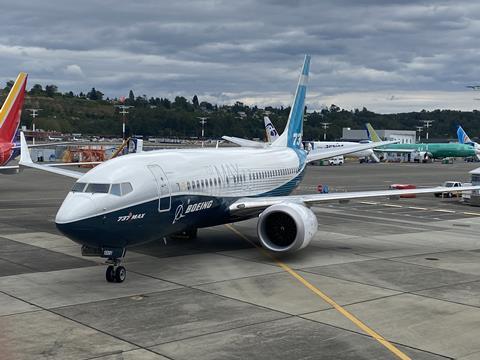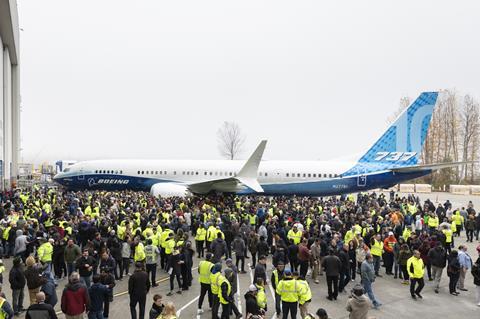Boeing is seeking temporary regulatory exemptions for a stall-management yaw damper (SMYD) system on the 737 Max 7 and Max 10, saying a classification change left it unable to demonstrate that the system meets “increased regulatory expectations”.
The company on 17 January requested the exemptions from the Federal Aviation Administration. It needs the approvals to achieve certification of both long-delayed types and to roll out an angle-of-attack (AOA) system update planned for all Max models, says Boeing’s request, released by the US government on 21 January.

“We continue to work under the oversight of the FAA to complete the certification process for the new 737-7 and 737-10,” Boeing says. “As part of that process, to meet increased regulatory expectations, Boeing is updating the analyses that support certification of software for the stall management yaw damper system.”
Boeing calls the SMYD “an electronics unit that provides stall warning, stall identification and yaw damper functions”.
Boeing in 2023 had received a separate exemption for the SMYD on the 737 Max 7, though that exemption applied to lightning and radiation rules. The new request applies to rules requiring that systems function as intended and that failures capable of preventing safe landings be “extremely improbable”.
“An exemption will deliver the 737-7 and 737-10 airplanes to customers sooner with enhanced safety,” Boeing’s filing says.
“The software will also include safety enhancements to the angle-of-attack system,” it adds. “A time-limited exemption for the yaw damper certification requirements will allow the angle-of-attack system safety enhancements to be retrofitted on in-service 737 Max models at an earlier point in time, while our team continues the work to certify the yaw damper.”
The company says the issue does not impact in-service 737 Max.
It insists the exemption poses “no adverse impact on safety” and notes that the Max 7’s and Max 10’s SMYD provides “an equivalent level of safety” as the SMYD on the Max 8 and 9.
The yaw damper system “has an established safety and reliability record based on 250 million flight hours over more than 25 years,” Boeing adds. “The specific software for the 737-7 and 737-10 has undergone extensive testing and reviews, which confirmed there is no impact from any software adjustments on the airplane’s safety or reliability.”
The FAA declines to comment.
The aircraft manufacturer has historically certificated SMYDs to “Level B” standards under aircraft-software guidance published by the Radio Technical Commission for Aeronautics. Level B applies to software for which failures are “hazardous”, according to online sources.
“During 737-7 development and certification of the yaw damper function, updated analysis led Boeing and the FAA to determine that the SMYD should now be certified to Design Assurance Level A,” Boeing’s exemption request says. Level A systems are considered those for which failure may be “catastrophic”.
Because the Max 7’s and Max 10’s SMYD has “not been shown to meet” Level A standards, “additional certification activity will be needed”, Boeing says.
It has requested the exemption be valid through end-October 2028. Between now and then, Boeing intends to “complete the certification activities necessary to show compliance”, it says. “This period also provides the time needed to retrofit airplanes delivered under this exemption, in order to bring them into compliance.”

The company has struggled for years to achieve the Max 7’s and Max 10’s certification. How those projects might be impacted should the FAA reject the latest exemption request remains unclear.
All 737 Max variants have similar SMYDs, with “minor” tweaks between Max variants to provide “consistent performance of the stall warning, stall identification and yaw damper functions”, Boeing says.
But the Max 10’s system additionally supports a new “Enhanced Angle of Attack” (EAOA) feature Boeing is developing for all Max models, not just for the 10.
The enhancements, part of Boeing’s response to two 737 Max accidents, will help the jets’ software better evaluate and detect erroneous AOA data, the company has said.
Boeing intends to retrofit jets already in service with the AOA update.
What is new is that Boeing now says it needs the exemption to do so.
“Without the time-limited exemption, the EAOA safety features cannot be enabled, delaying critical safety enhancement,” Boeing’s filing says.
Assuming the FAA approves the exemption, Boeing intends to demonstrate the SMYD’s compliance after achieving the Max 7’s and Max 10’s certification, and also after finishing its AOA enhancement.
What prompted Boeing to uncover the latest SMYD issue remains unclear, but the company had already been working through separate issues with that system on the 737 Max.
In a June 2023 letter to the FAA, Boeing’s 737 Max development chief project engineer Gary Hamatani disclosed that the Max 7’s SMYD “was not compliant” with rules related to withstanding radiation or lightning strikes. He also said Boeing was working on SMYD changes for “all other 737 Max models”.
The FAA in September 2023 approved a request from Boeing that exempted the 737 Max 7 from lighting and radiation-related rules, through early 2027.


























